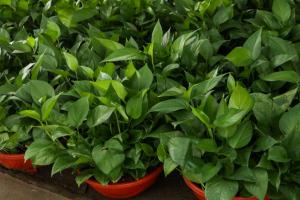Introduction
Tropical plants are a great way to add color and life to any indoor or outdoor space. These plants are often characterized by bright, bold colors and unique shapes that are sure to catch the eye of anyone who comes across them. In this article, we will guide you through the process of potting tropical plants to ensure they thrive in their new environment.
Choosing the Right Pot
The first step in potting tropical plants is choosing the right pot. It is important to select a pot that provides adequate drainage as tropical plants prefer an environment that is moist, but not waterlogged. Terra cotta pots are a popular choice as they are porous and allow for water to escape easily. However, plastic pots are also a good option as they are lightweight and easy to move, which can be beneficial when it comes time to repot your plant.
Preparing the Potting Mix
The next step in potting tropical plants is preparing the potting mix. A good potting mix should be light and airy while also retaining moisture. A mixture of peat moss, perlite, and vermiculite is an excellent option for tropical plants. It is important to ensure that the potting mix is well-drained, as tropical plants do not tolerate sitting in standing water for long periods of time.
Adding Fertilizer
Before potting your tropical plant, it is a good idea to add fertilizer to the potting mix. Tropical plants require regular fertilization to ensure they receive the nutrients they need to thrive. A slow-release fertilizer is a good option as it will release nutrients slowly over time, providing your plant with a consistent source of nutrients for several months.
Potting Your Plant
Now that you have prepared your pot and potting mix, it is time to pot your tropical plant. Firstly, gently loosen any roots that may be tangled or compacted as this will allow them to grow more freely in their new environment. Next, place your plant in the pot and fill in the gaps with the potting mix, ensuring that the soil is level with the top of the pot. Finally, water your plant thoroughly to help settle the soil and eliminate any air pockets that may have formed.
Caring for Your Tropical Plant
After potting your tropical plant, it is important to care for it properly to ensure it thrives in its new environment. Tropical plants prefer bright, indirect sunlight and moist soil, so be sure to keep your plant in a location that receives plenty of light but is not exposed to direct sunlight. Water your plant regularly, but ensure that the soil does not become waterlogged as tropical plants are susceptible to root rot. Regularly fertilize your plant and repot it when it outgrows its current pot.
Conclusion
Potting tropical plants can be a rewarding experience, and by following the steps outlined in this article, you can ensure your plant thrives in its new environment. Remember to choose the right pot, prepare a well-draining potting mix, add fertilizer, pot your plant correctly, and care for it properly to ensure it grows to its full potential. With a little bit of care and attention, your tropical plant will add color and life to your home or garden for years to come.

 how many times do yo...
how many times do yo... how many planted tre...
how many planted tre... how many pine trees ...
how many pine trees ... how many pecan trees...
how many pecan trees... how many plants comp...
how many plants comp... how many plants can ...
how many plants can ... how many plants and ...
how many plants and ... how many pepper plan...
how many pepper plan...






























